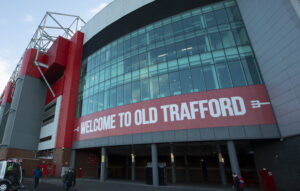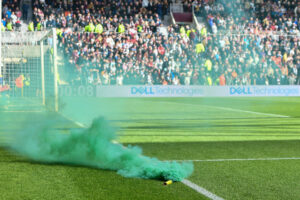Benfica’s original Estadio da Luz started its construction on June 14, 1953. Within two years, the 40,000 capacity stadium was a reality. The name of the stadium came from the name of a neighbourhood located to the north of the area called ‘Luz’ or ‘Light’. This was a reference to the Church of Our Lady of the Light. Its inauguration took place on December 1, 1964, which was a Portuguese national holiday. There was a festival of football with the centrepiece being Benfica hosting eternal rivals Porto in the stadium’s debut match.
Benfica’s Estadio da Luz
Renovations Galore
The stadium saw as many stylistic changes as the great David Bowie. There were five important renovations throughout its time. Its original attendance was 40,000 during the 1950s. Then, the capacity would be increased to 70,000 during the 1960s. This included the construction of the first phase of its third tier as well as the installation of floodlights.
The next major cosmetic operation was in the mid-1980s with the completion of the third tier. This upgrade brought the stadium capacity up to an impressive 120,000. Its main characteristics featured a sprawling oval bowl with red grandstands. There were four tall floodlights painted in gold which towered above the stadium. Also, there was a huge white entrance to welcome supporters.
Due to the ground becoming all-seater, the Estadio da Luz decreased its capacity to 78,000 during its final eight years from 1994 to 2002.
There were five renovations over four key spells and then the original da Luz would be no more. That day arrived on March 22, 2003, when Benfica played their final match at their original home. But, a goal by Simão Sabrosa from the penalty spot against Santa Clara gave a fitting finale to the cathedral.
Colossal Attendances for Benfica Matches
The Estadio da Luz, or the Stadium of Light, held, at one time, the record of the biggest stadium in all of Europe. With a capacity of 120,000 at one stage, it was the third-largest stadium in the world. During this time, the record attendance was a match between Benfica and Porto with 135,000 supporters in the da Luz. This was due to the stadium having no seats so more people managed to get in than the stated capacity. It was a victory for the home side by three goals to one with the match taking place on January 4, 1985.
Let There Be Light at Benfica
With times changing and Benfica wanting to modernize, a new stadium began to take importance. This culminated in the new Estadio da Luz brought to life with a capacity of 64,400. Its full name is Estádio do Sport Lisboa e Benfica. Its opening day was on the 25th October 2003 as Benfica beat Uruguayan outfit Club Nacional 2-1. Also, the construction of the new stadium had another main aim. This was to welcome the European Championships, which were to be held the following year. The stadium hosted five matches, including the showpiece final. But, unfortunately for the host, Portugal, who made the final, their dreams on winning on home soil suffered heartache thanks to the well-organized Greeks.
The Eagle Has Landed
At a time when space exploration is back in the front of people’s minds, this reference comes from the famous eagle which flies over home matches before kick-off. The original eagle, known as Vitória, started to fly around the stadium from the inauguration of the Estadio da Luz in 2003.
Since 2011, another eagle, also named Vitória, has been flying around the stadium at kick-offs. The tradition consists of Vitória, with red and white ribbons, flying in and around the stadium until it lands on the club crest. What is special is that crest is without its featured eagle so Vitória completes the badge in a novel way. There is a great on-board video of the eagle flying from the top of the stadium all the way down and onto its perch. It is well worth a look from an internet search.
Landmark Matches in Benfica
Famous games include the 1992 European Cup Winners Cup final between Werder Bremen and AS Monaco, which ended 2-0 to the Germans. The 1983 UEFA Cup final second-leg as Benfica drew with Anderlecht 1-1. Yet, the Belgian’s won the cup 2-1 on aggregate. Then there was the 1962 Intercontinental Cup second-leg between Santos and Benfica -a match which brought together two icons of world football in the Brazilian Pele and the Portuguese Eusébio. The match ended a thrilling 5-2 to Santos to beat Benfica in their own back yard. This followed the first leg result of the Copa Libertadores champions defeating the European Cup winner 3-2 in the famous Estádio do Maracanã.
The original Estadio da Luz was a colossal coliseum and certainly a stadium never to be forgotten.
Main Photo






